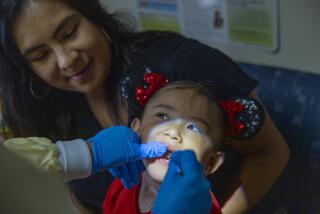What a Mouthful! Dental Talk for the Millennium
- Share via
This week, in honor of all the jawing about the new millennium, Booster Shots presents a selection of mouth-themed items. For instance, did you know that George Washington, contrary to popular legend, did not wear wooden false teeth? Instead, this country’s first president sported ones made of ivory, hippo tusk and, at times, dentures consisting of his own teeth mounted on a gold base.
So we learned from Dentalnotes, a newsletter from the Academy of General Dentistry, based in Chicago. Dentalnotes also informed us that Herbert Hoover visited the dentist more than 300 times during his lifetime and that both Washington and Andrew Johnson avoided speaking engagements because of ill-fitting false teeth and other mouth-related problems.
Moving on, the newsletter offered tips on how those of us with various personality types can best communicate with our dentists.
“Visually dominant” people, the newsletter suggested, should ask the dentist to draw pictures--and even use a camera to explore the mouth--to explain what’s going on with the patient’s teeth.
“Auditory dominant” types should ask dentists to verbally explain dental problems and procedures.
And touchy-feely types will “need time to develop feelings about the dentist,” we are told, and may not gain much from pictures or detailed explanations. Instead, advised the newsletter, “ask the dentist for a model of your teeth so you can feel it with your hands.”
Continuing our theme, we’re delighted to learn that scientists at Stanford University have expanded the biodiversity roster by exploring the warm, moist ecology of people’s mouths.
According to an article in the Proceedings of the National Academy of Sciences, the Stanford researchers--whose larger goal is to discover hitherto unknown bacteria all over the human body--scraped the sides of people’s mouths and probed deep in the pockets between teeth and the gum line. Then they either smeared the findings onto small plates of nutrient-rich Jell-O and watched to see what grew, or smashed the bugs up and searched for pieces of their genes.
The result: 37 new bacteria, to add to the roughly 500 mouth bugs scientists already knew about. Something nice to think about the next time you kiss someone.
Of Hot Dogs and Foods of the Future
Finally, a few food items. Perhaps some of you have felt that low-fat and fat-free hot dogs don’t taste quite as yummy as their full-fat counterparts? Scientists in Northern Ireland, reporting in the Journal of Agricultural and Food Chemistry, have an explanation.
The fat in a hot dog, they’ve found, soaks up chemicals that give franks their flavor. It releases those flavor chemicals slowly as we chomp the franks up in our mouth. Flavors, in other words, last longer for a fattier frank.
And scientists are also having fun making food predictions for the new millennium, reported the Chicago-based Institute of Food Technologists. Among the forecasts:
“Grocery store shelves lined with functional foods that target people at risk for specific health problems,” predicted Fergus Clydesdale of the University of Massachusetts.
“Vending machines that allow you to program in your health profile and then obtain a pill with the optimal nutrients that you need,” suggested Manfred Kroger, professor emeritus at Penn State.
And we like another of Kroger’s predictions: “Insects and worms are good sources of protein and widely available. Why not put them on pizza or add them to snack foods?”






